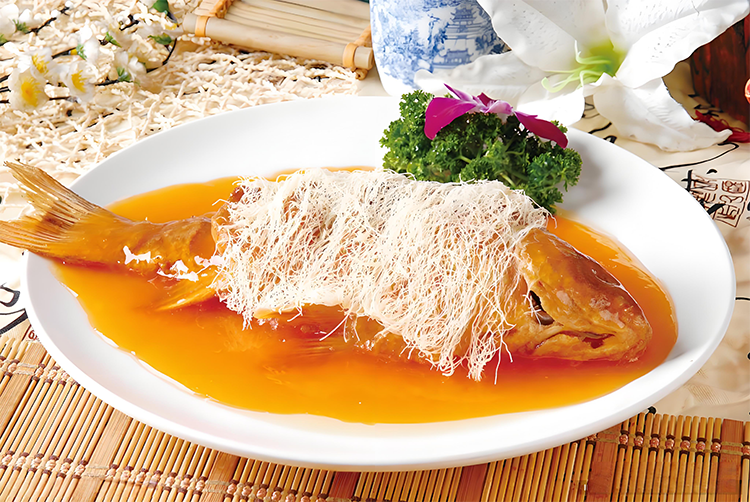Kaifeng Carp with Crispy Noodles
1. A Thousand-Year Taste: Kaifeng Carp with Crispy Noodles, A Bite of Song Dynasty Elegance
Stroll through Kaifeng’s ancient streets and you’ll find history at every corner. But one local flavor brings the Northern Song capital to life on your palate: Kaifeng carp with crispy noodles (Liyu Beimian). Often called a culinary “living fossil,” this dish pairs sweet-and-sour fried carp with a delicate, crunchy nest of fried thin noodles. For food travelers, it’s not just a dish—it’s a tasting of centuries.
2. Origins: From Imperial Tables to Market Stalls
The story begins in Song-era Bianjing (today’s Kaifeng). Records in Meng Yuanlao’s Tokyo Dreaming (Dongjing Menghuan Lu) mention a popular preparation called “sugar-vinegar fried fish”—deep-fried carp finished in a glossy sweet-and-sour sauce. When hand-pulled noodles reached the capital later, local cooks innovated: they stretched the dough into hair-fine strands known as “dragon beard” noodles, fried them until they turned golden and crisp, and draped this crunchy web over the saucy fish. The combination—sugar-vinegar fish crowned with bei mian —soon became a signature Kaifeng specialty, cherished for both its flavor and auspicious symbolism.

3. Ingredients and Technique: Craft Behind the Crispy
Authentic Kaifeng carp with crispy noodles depends on three elements done well:
- The Carp: Fresh Yellow River carp is preferred for its firm, mild-flavored flesh. Kaifeng’s proximity to the Yellow River historically supplied the city with ideal fish—plump, with a slightly sweet profile and minimal muddy taste.
- The Sugar-Vinegar Sauce: The soul of the dish is a glossy, deep-red sweet-and-sour sauce made from sugar, aromatic vinegar, Shaoxing wine or cooking wine, garlic, and ginger. The sauce is reduced to a syrupy consistency that clings to the fish, balancing richness and acidity to cut through the fried coating.
- The Crispy Noodle Topping (Bei Mian): Making true bei mian is a craft. Dough is repeatedly stretched into threads so fine they resemble dragon whiskers. These threads are fried in temperature-controlled oil until they are light, airy, and shatteringly crisp—providing the textural contrast that defines the dish.
4. How to Taste It: A Flavor and Texture Performance
Eating Kaifeng carp with crispy noodles is almost ceremonial.
- First, try the crispy noodle by itself: break off a portion while it’s hot and listen for the crunch—its toasted wheat and oil aroma primes your palate.
- Next, uncover the saucy carp beneath. The fish’s exterior may have a slight crisp from frying, while the interior remains tender and flaky—each bite brightened by the balanced sugar-vinegar glaze.
- Finally, combine them: dip or briefly rest some bei mian in the sauce so it softens slightly while retaining some crunch. The interplay of crisp and tender, sweet and tangy, creates the dish’s unforgettable climax.

5. Traveler Tips: Where and How to Enjoy It in Kaifeng
- Where to go: Seek out reputable, long-established local restaurants that preserve traditional techniques. Local favorites and historic eateries in Kaifeng’s old city are best for authentic bei mian preparations.
- Timing: This is a made-to-order specialty. Allow time for preparation—good carp and crisp noodles require attention.
- Pairings: Balance the richness with a light soup or seasonal vegetables. Kaifeng’s dumplings and clear broths make excellent companions.
- Cultural tip: As you taste, imagine the bustling Song-dynasty markets—this dish carries both culinary skill and a sense of the city’s past prosperity.
6. Simple Home Version (For Food Lovers, Not Purists)
If you want to recreate a version at home:
- Choose a fresh carp or sea bass, score it, season with salt and cooking wine, then coat lightly in starch and deep-fry until golden.
- Make a sweet-and-sour sauce with tomato paste or ketchup, sugar, vinegar, garlic, and a splash of cooking wine; reduce until glossy and thick, then pour over the fish.
- For the crispy topping, fry very thin dried egg noodles or vermicelli until golden and crisp; drain and arrange over the sauced fish.
This quick adaptation won’t replace a master chef’s bei mian, but it captures the sweet-tangy and crunchy spirit of Kaifeng’s classic.

7. Conclusion
Kaifeng carp with crispy noodles is more than a local specialty—it’s a culinary bridge to the Song dynasty. Every element—from Yellow River carp to glazed sauce and fragile fried noodle—tells a story. When you visit Kaifeng, don’t miss this delicious piece of living history: a sensory way to taste a thousand years of Chinese culinary tradition.


